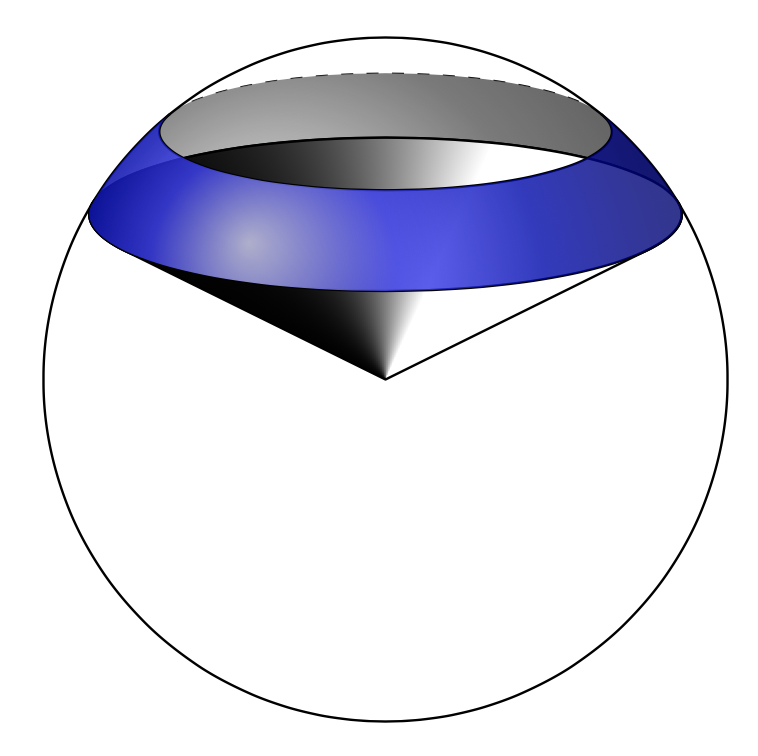I do not think that it will be fun to make this work for all possible view angles, but for those similar to your screen shot it is not too difficult.
```
\documentclass[tikz,border=3mm]{standalone}
\usetikzlibrary{calc,decorations.pathreplacing,3dtools}%https://github.com/marmotghost/tikz-3dtools
\begin{document}
\pgfdeclarelayer{background}
\pgfdeclarelayer{foreground}
\pgfsetlayers{background,main,foreground}
\begin{tikzpicture}[declare function={R=2;},line cap=round,line join=round,
sphere/.style={ball color=blue,3d/screen coords,fill opacity=0.8,
insert path={(0,0) circle[radius=R]}}]
\begin{scope}[3d/install view={phi=110,psi=0,theta=75}]
\path (0,0,0) coordinate (O) (0,0,1) coordinate (P) (0,0,1.5) coordinate (Q);
\tikzset{3d/circle construction/.code={
\draw[stored path/reset coordinate index,
3d/hidden/.style={store path=bg#1},
3d/visible/.append style={on layer=foreground}]
pic{3d/circle on sphere={R=2,P={(#1)}}};
\pgfmathtruncatemacro{\Nhid}{tikztdindexoflastcoordinate}
\ifnum\Nhid>0
\path[stored path/first coordinate of=bg#1] coordinate (bg#10)
[stored path/last coordinate of=bg#1] coordinate (bg#11);
\fi
\draw[stored path/reset coordinate index,
3d/hidden/.append style={on layer=background},
3d/visible/.style={store path=fg#1}]
pic{3d/circle on sphere={R=2,P={(#1)}}};
\pgfmathtruncatemacro{\Nvis}{tikztdindexoflastcoordinate}
\ifnum\Nvis>0
\path[stored path/first coordinate of=fg#1] coordinate (fg#10)
[stored path/last coordinate of=fg#1] coordinate (fg#11);
\fi}}
\tikzset{3d/circle construction/.list={Q,P}}
\pgfmathtruncatemacro{\itest}{(\Nhid>0?1:0)+(\Nvis>0?2:0)}
\begin{scope}[3d/screen coords]
\clip[overlay,on layer=background,even odd clip]
[stored path/restore path=bgQ] -- ++ (0,R) -| cycle
[generous outside path];
\clip[overlay,even odd clip]
[stored path/restore path=fgQ] -- ++ (0,R) -| cycle
[generous outside path];
\clip[overlay,on layer=foreground,,even odd clip]
[stored path/restore path=fgQ] -- ++ (0,R) -| cycle
[generous outside path];
\ifcase\itest
% no path
\or
% only hidden
\begin{scope}[on layer=background]
\clip[stored path/restore path=bgP];
\path[sphere,ball color=gray];
\end{scope}
\or
% only visible
\begin{scope}[on layer=foreground]
\clip[stored path/restore path=fgP];
\path[sphere];
\end{scope}
\or
\begin{scope}[on layer=background]
\clip let \p1=(bgP0),\p2=(bgP1),\n1={Mod(atan2(\y1,\x1),360)},
\n2={Mod(atan2(\y2,\x2),360)}
in (bgP0) [stored path/append path=bgP] -- (bgP1)
arc[start angle=\n2,end angle=\n1,radius=R] -- cycle;
\path[sphere,ball color=gray];
\end{scope}
\begin{scope}[on layer=foreground]
\clip let \p1=(fgP0),\p2=(fgP1),\n1={Mod(atan2(\y1,\x1),360)},
\n2={Mod(atan2(\y2,\x2),360)}
in (fgP0) [stored path/append path=fgP] -- (fgP1)
arc[start angle=\n2,end angle=\n1,radius=R] -- cycle;
\path[sphere];
\end{scope}
\fi
\end{scope}
\pgfmathsetmacro{\myh}{tddistance("(O)","(P)")}
\pgfmathsetmacro{\myr}{sqrt(R*R-\myh*\myh)}
\path (P) pic{3d/shaded cone={r=\myr,h=-\myh}};
\draw[3d/visible,3d/screen coords] circle[radius=R];
\end{scope}
\end{tikzpicture}
\end{document}
```
